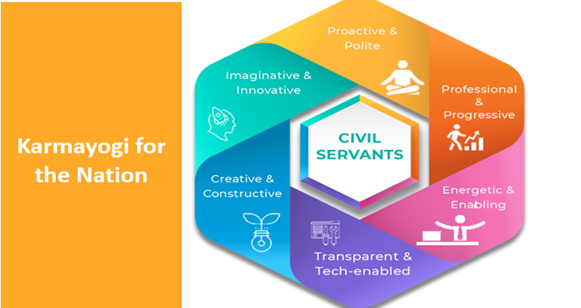Context
- The article highlights the significance of citizen-centric and citizen-enabled governance to respect the voice of the citizenry and to ensure that all development reaches the person standing at last mile, thus enriching democracy.
Meaning of Citizen Engagement
- It refers to how citizens participate in the decision-making processes such as voting, attending public meetings and town halls, volunteering, etc.
- It leads to a range of outcomes, including more effective services and more responsive and accountable states and enlightened citizenry.
- Moreover, citizen engagement is not about confrontation or merely about expressing restlessness and dissatisfaction.
- It is more about collaborative partnerships and dialogue intended towards inclusion, empowerment and is a political process.
- It is a core component of any governance system and is highly embedded in the nature of the political and governance context and existing power relations.
- In democracies, citizen engagement is a basic principle because it is understood that governments derive their authority and power from the people.
- Also, citizen engagement should neither be viewed as the “citizen against the state” nor as the “state against the citizen”, but as two complementary forces working together to ensure the overall development of a community or a nation.
- The Indian democracy is mature in the sense that there is an intentional attempt by the state to make development citizen-centric.
- The PM’s call for citizen centricity should be seen as a part of the social compact that the government is now creating between the citizens and the public service delivery systems.
- He has repeatedly referred to “Jan Bhagidari” and that all development must keep the person at the last mile in mind (Antyodaya).
Relevance of Discourse in Citizen Engagement
- Citizen engagement towards democratizing the process of development necessarily involves a constructive dialogue between and amongst all stakeholders - state, citizenry, private sector, media, civil society and academia.
- This needs to be accompanied by redrawing boundaries of engagement and roles that stakeholders have traditionally assumed for themselves.
- Also, this meaningful dialogue among multiple stakeholders can sustain only when there is mutual trust.
- It also requires an appreciation of interdependence and reciprocity, hence giving equal and dignified spaces in the decision making and execution process.
- However, multi-stakeholder engagement would involve challenges as the adoption of the partnership approach by all parties involved will require shedding biases about each other.
- The citizenry or community is not necessarily a homogenous mass of people and caution must be taken of elite capture within citizen groups as well and respecting the last citizen’s voice.
Reinvigorating Citizen Oriented Governance
- Traditionally, governance structures hold the power to make decisions that affect the lives of citizens.
- But citizen-centric governance focuses on providing citizens with access to information, services and resources and on engaging them in the policy-making process.
- However, the concept of citizen-centric governance is constantly evolving.
- Hence putting into action citizen’s sustained engagement requires clarity in the actions that civil servants perform and how citizens engage with the state.
- This engagement is a two-way interaction between citizens and governments that give citizens a stake in decision-making to improve development outcomes.
- It necessarily demands a shift in the mindset of civil servants through an exemplary programme which looks at the complete ecosystem of capacities of civil servants in delivering on this mandate.
India’s Citizen-centric Platform for Good Governance
- MyGov launched in 2014 has been established as Government of India’s Citizen Engagement Platform.
- It collaborates with multiple Government bodies/Ministries to engage with citizens for policy formulation and seeks the opinion of people on issues/topics of public interest and welfare.
- It has had significant success in terms of engaging with citizens. For example, logos and taglines of key National Projects like Swachh Bharat, National Education Policy, Digital India Campaign, etc. have been crowdsourced through MyGov.
- Meghalaya has also in 2022 has launched “Citizen Engagement and Communication Programme” to spread awareness amongst the masses to avail benefits of the schemes being launched by the Government and improve governance in all aspects.
Mission Karmayogi - National Programme for Civil Services Capacity Building
- It has been carefully designed for capacity building of the civil servants so that they are entrenched in Indian Culture and sensibilities and remain connected, with their roots, while they learn from the best institutions and practices across the world.
- It aims at building a future-ready civil service with the right attitude, skills and knowledge, aligned to the vision of New India.
- The Mission envisages a comprehensive reform of the capacity building apparatus at the individual, institutional and process levels for efficient public service delivery.
- Hence, it has been strategically working to build the capacities of civil servants through various innovative interventions to sensitise and reframe the fabric of citizen participation.

Demonstration of Capacity Enhancement of the Service Personnel
- The railway employees, Gramin Dak Sevaks, police personnel in the UTs and employees of BSNL recently went through an outcome-based capacity-building programme.
- This was aimed at shifting them from thinking like a “karmachari” to acting like a “karmayogi”.
- Several personnel from the ministries of civil aviation, mines, ports and shipping, and steel have also immersed themselves in private sector ecosystems.
- This is aimed to better appreciate the challenges faced by the latter and how these personnel can enhance the ease of living and doing business from a citizen’s perspective.
Conclusion
- The PM’s emphasis to make a paradigm-shift towards citizen-centric governance and that citizen should be at the centre of everything that the government did provides the catalytic first step to ensure strengthening of grassroot democracy in the nation.
- This could be furthered by proper channels of information dissemination, gathering valuable inputs and indigenous knowledge of the citizenry and putting appropriate grievance redressal mechanisms in place.









